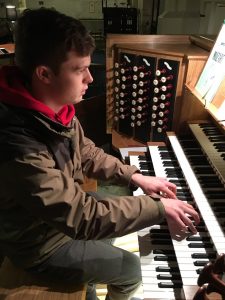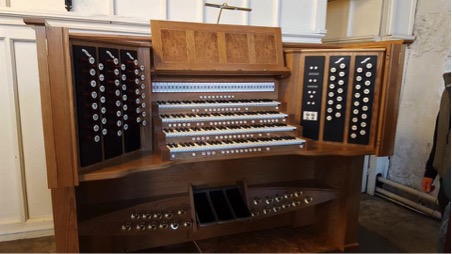New at St Michael’s – digital pipes
 By Jon Pilgrim, organ scholar. In my time as organ scholar for the University over the past two and a half years, the organ of St. Michael’s church has undergone huge change. I have, however, never used their pipe organ, despite playing there a minimum of twice a week. The pipes on the south side are, at this point, purely for show. The pipe organ at St Michael’s has been out of action for as long as I have been here; we have instead been using a digital organ console hooked up to a computer running the program Hauptwerk, which uses samples taken from real church organs from around the world. There are many organ purists who disapprove of such a set-up, but I believe it is a fantastic cost-friendlier option (not only in its building and installation, but also it doesn’t require constant tuning or repairing of blowers, pipes, motor etc.) and still manages to create an impressive and realistic sound.
By Jon Pilgrim, organ scholar. In my time as organ scholar for the University over the past two and a half years, the organ of St. Michael’s church has undergone huge change. I have, however, never used their pipe organ, despite playing there a minimum of twice a week. The pipes on the south side are, at this point, purely for show. The pipe organ at St Michael’s has been out of action for as long as I have been here; we have instead been using a digital organ console hooked up to a computer running the program Hauptwerk, which uses samples taken from real church organs from around the world. There are many organ purists who disapprove of such a set-up, but I believe it is a fantastic cost-friendlier option (not only in its building and installation, but also it doesn’t require constant tuning or repairing of blowers, pipes, motor etc.) and still manages to create an impressive and realistic sound.
Since last November I had been playing Romsey Organ Works’ loan console while we waited for them to custom build us a new one. It used samples taken from a 1902 organ in Metz by the renowned French organ builder Aristide Cavaillé-Coll, who also built organs for Notre Dame de Paris, Saint-Sulpice in Paris and many others. Whilst it made a beautiful sound in St. Michael’s, the speakers being round the corner from the organ console and choirstalls was far from ideal. The sound it made was always quite distant and lacking in clarity – something especially important for choir accompanying.
The eagerly awaited new console arrived on December 1st, and required 7 people to move it from the delivery van to its spot in the church. Once it was set in place, the organ builders set to work connecting the console up to the speakers and computer, and configuring it to the software. We were told to leave them to it, as this process was to go on for some time (5 hours in total).

The new 4-manual console runs off samples taken from the Henry ‘Father’ Willis organ of Hereford Cathedral, and has 67 different stops (as opposed to 22 that the Cavaillé-Coll offered). A 4-manual setup also has the advantage that sounds can be more acutely isolated from one another if desired, and blended together with stops from different manuals in a great many more ways. This allows much more control over the sounds one can create, something which is important not only with accompaniment of the choir or congregation, but also with solo organ work.
There have also been changes to the speaker set up, with certain divisions of the organ being played through speakers near the choirstalls, whilst others have been left round the corner. This not only gives the opportunity for antiphonal response between these divisions, but also for the choir and me to be able to hear the organ more immediately.
I also play at Romsey Abbey, where they have a traditional pipe organ, so it is a completely different experience. The pipes are right by the console so the touch is quite immediate, though the choirstalls are a bit further away from the console and require me to use a TV screen to see the choirmaster.
I am extremely grateful to the Friends of St. Michael’s, Romsey Organ Works, Fr. David Deboys (Team Vicar in the Southampton City Parish), Keith Davis (leader of Cantores Michaelis), and everyone else involved for making the new organ happen.

